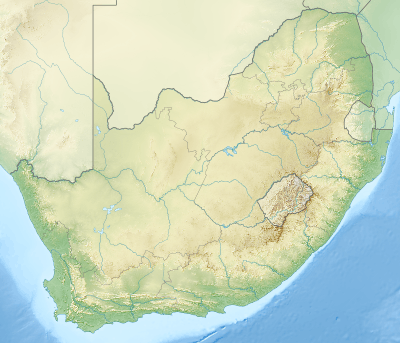Lebombo Mountains
| Lebombo Mountains (Lubombo / Libombos) | |
|---|---|
 Part of the Lebombo mountain chain, including Ghost Mountain; seen from Mkuze | |
| Highest point | |
| Peak | Mount Mananga |
| Elevation | 776 m (2,546 ft) |
| Listing | List of mountain ranges of South Africa |
| Coordinates | 26°15′0″S 32°0′0″E / 26.25000°S 32.00000°ECoordinates: 26°15′0″S 32°0′0″E / 26.25000°S 32.00000°E |
| Dimensions | |
| Length | 800 km (500 mi) N/S |
| Width | 100 km (62 mi) E/W |
| Geography | |
 Lebombo Mountains (Lubombo / Libombos) | |
| Countries | Mozambique, South Africa and Swaziland |
| Geology | |
| Orogeny | Gondwanian |
| Age of rock | Precambrian |
| Type of rock | Rhyolite and basalt |
The Lebombo Mountains, also called Lubombo Mountains (Portuguese: Montes Libombos), are an 800 km long, narrow range of mountains in Southern Africa. They stretch from Hluhluwe in KwaZulu-Natal in the south to Punda Maria in the Limpopo Province in South Africa in the north. Part of the mountains are also found in Mozambique and Swaziland.
Description
Geologically, the range is considered a monocline; part of a rifted volcanic margin.[1] The Lebombo monocline was aligned with the Explora Escarpment off-shore Dronning Maud Land, Antarctica, before the break-up of Gondwana.[2] The Lebombo monocline strikes N-S and dips to the east. It is composed of a sequence of Jurassic age volcanic rock, both basaltic lavas and rhyolitic flows and tuffs. The sequence rests on essentially horizontal Karoo Supergroup sedimentary rocks of the Kalahari Craton to the west and is overlain by Cretaceous to recent sediments to the east. The alternating resistant rhyolite and easily eroded basalts produce a series of parallel sharp cuesta ridges separated by savanna plains.[3]
The range is relatively low with heights between 450 and less than 800 m. The highest peak is 776 m high Mount Mananga. The 480 m high Longwe is the highest point in the Lebombo Range north of the Letaba River.[4]
The mountains dominate Lubombo District in Swaziland. Towns in the area include Siteki in the centre, Lubhuku in the west and Mayaluka and Big Bend in the south with the Lusutfu River running past the southern region of the mountain range. At the north lie the towns of Simunye, Tambankulu and Namaacha, and the Mlawula Nature Reserve as well as the Mbuluzi River.
A number of rivers, including the Pongola, Mkuze, and Lusutfu, cross the mountains from west to east.
The name of the mountains is derived from the Zulu word ubombo meaning "big nose".
Protected areas
Kruger National Park and Phongolo Nature Reserve protect part of the range.
References
- ↑ Watkeys, M.K. (2002). "Development of the Lebombo rifted volcanic margin of southeast Africa". GSA Special Papers. Geological Society of America. 362. doi:10.1130/0-8137-2362-0.27. Retrieved 14 May 2010.
- ↑ Jokat, W.; Boebel, T.; König, M.; Meyer, U. (2003). "Timing and geometry of early Gondwana breakup" (PDF). Journal of Geophysical Research: Solid Earth. 108 (B9). doi:10.1029/2002JB001802. Retrieved 30 July 2016.
- ↑ Manninen, Tuomo, et. al., The Karoo Volcanic Rocks and Related Intrusions in Southern and Central Mozambique, Geological Survey of Finland, 2008, Special Paper 48, pp. 211–250
- ↑ Echo System